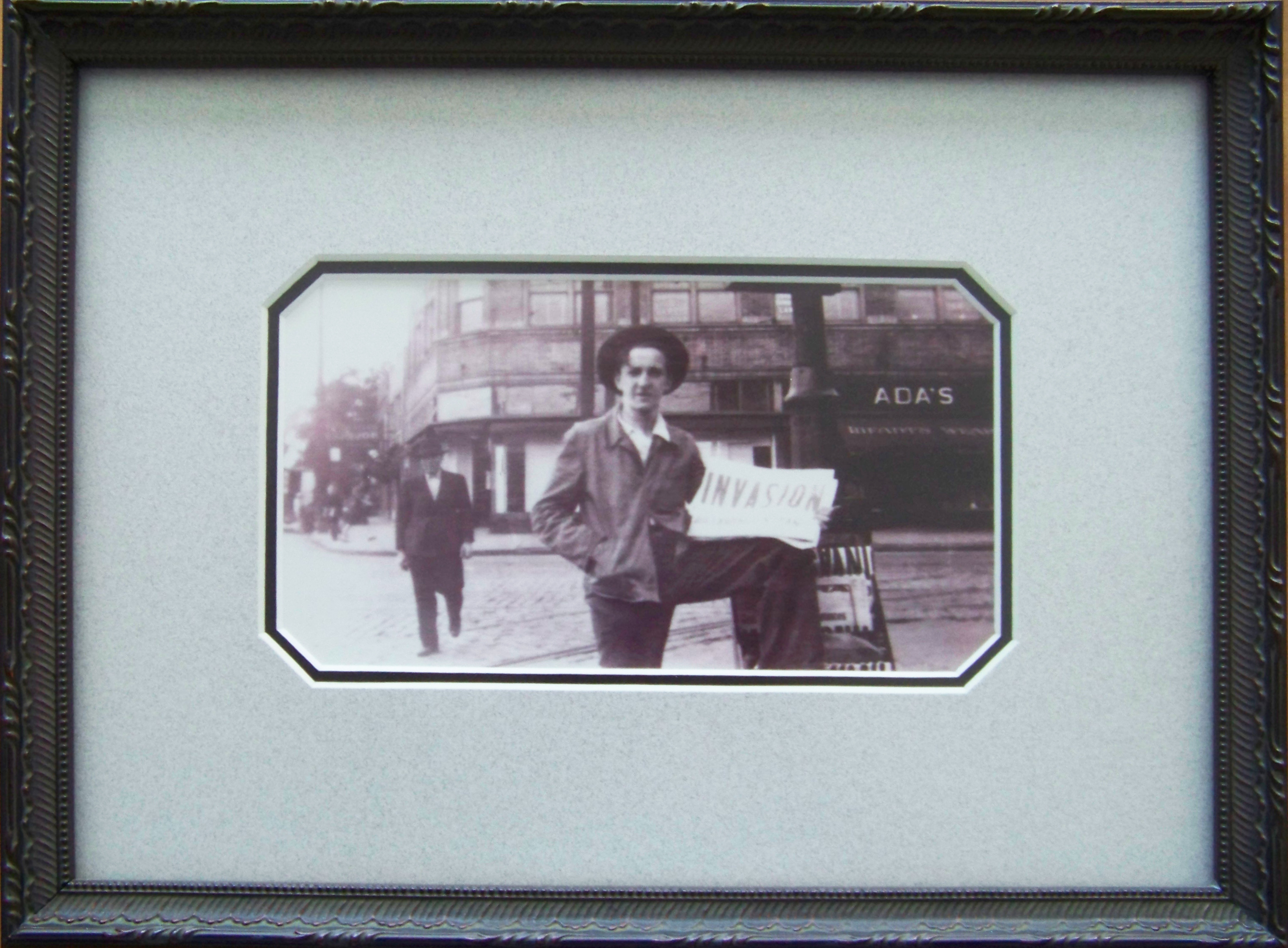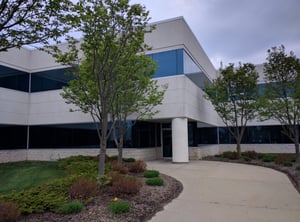AMT Celebrates 30 Years in Business!
On August 11, 2019, Applied Manufacturing Technologies celebrated 30 years in business.
 Thanks to our loyal customers, strong partnerships, and talented employees, on August 11, 2019, AMT celebrates the company’s 30th anniversary. In honor of that event, President and CEO Michael Jacobs reminisces about the twist and turns of the past three decades, and finding his personal life vision along the way. Thank you to all that have been a part of our success!
Thanks to our loyal customers, strong partnerships, and talented employees, on August 11, 2019, AMT celebrates the company’s 30th anniversary. In honor of that event, President and CEO Michael Jacobs reminisces about the twist and turns of the past three decades, and finding his personal life vision along the way. Thank you to all that have been a part of our success!
The Entrepreneurial Spirit Took Root Early
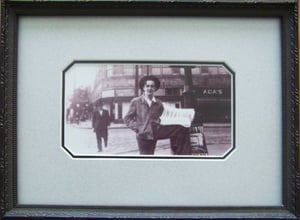 “If you have a paper route, you are running a business,” Mike said. “You are buying a product and reselling it to a customer. You’ve got customers, you’ve got collection issues. A lot of that motivation to work for myself started during my paper route.” Mike worked his paper route for several years. He started with a small route, and grew it to one of the largest routes in the city.
“If you have a paper route, you are running a business,” Mike said. “You are buying a product and reselling it to a customer. You’ve got customers, you’ve got collection issues. A lot of that motivation to work for myself started during my paper route.” Mike worked his paper route for several years. He started with a small route, and grew it to one of the largest routes in the city.
An important role model for Mike in his early years was his father, who was also in business for himself with the newspaper. “His independent spirit had a lot to do with my motivation,” Mike said.
The Journey Began with Two Big Companies
After university, Mike worked for Westinghouse and then Eaton Corporation, where he worked as a software engineer. Along the way, Mike found that the big-company environment with the inevitable politics and often-cumbersome procedures was not to his liking. After an economy downturn resulted in staggering layoffs in his group and seeing great employees being laid off before less productive counterparts, Mike experienced a pivotal moment in his career. “I needed to work for a smaller company.”
Mike had been following the growth of Silicon Valley in California from the beginning, and was familiar with startups like Apple and other computer companies in the region. In 1983, Mike made the decision to look for a more entrepreneurial atmosphere, and hopefully to find a position at a Silicon Valley-type startup company.
Building an Industry Network
Mike had many job offers, and decided to take a position with General Motors FANUC (GMF), just after the company had formed. “I liked what GMF was doing: the opportunities it was presenting people and the energy there.”
Mike was the first technical manager hired from outside of GM or FANUC, and he grew both his technical and managerial skills while at GMF. “I had the luxury to work on a startup within a startup, but I didn’t have to take on the responsibilities of payroll, employees, taxes, and those things,” Mike said.
One of the developments that GMF tasked itself with was the development of a product to program robots with computer graphics. Mike was chosen to build and lead that team. “I got to focus on the aspects of product startup: developing the product, focusing on the team, focusing on the design, and being involved in the marketing and sales process. It was a great experience for me.”
While at GMF, Mike was in a visible role in the product development. He got to know many of the players in the emerging industry, and grew a sizeable personal network.
Susan, Mike’s First Partner
After spending six years with GMF, Mike began to get the entrepreneurial urge again. One day at home in the kitchen with his wife Susan, Mike made a comment about leaving GMF to do a startup on his own. Susan didn’t miss a beat and said, “You know, Mike, either you DO that startup, or you have got to quit talking about it.”
With two small children at home, Mike had reservations about taking on the time-consuming venture of starting a new business right then. Susan understood the time commitment Mike would need to make, and she agreed to take up the slack at home so he could focus on his business venture. “She said she was willing to do that, and understood it. And I quit; I quit my job at GMF,” Mike said.
“I started entrepreneuring. I was really doing what our people in AMT Services do now. I programmed robots, I designed circuits for control systems and implemented those… It’s what today they call the gig economy.”
AMT Doubles Employees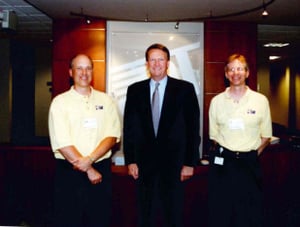
Mike tapped into the robotics and automation industry network he had developed at GMF, which allowed him to stay busy with his consulting. “You let people know you are out there, and one person tells another; it’s how a network works.”
For nine months, Mike continued finding jobs and executing them on his own. He would alternate between periods of engineering work and sales work, with his income fluctuating as he moved between the two pursuits. “You can’t sell when you are working, and you can’t work when you are selling.”
While out looking for his next gig, Mike found a project that was too large for one person. Ideally suited to one full-time and one part-time worker, Mike called a former GMF coworker, Don Stephanic. “Don and I had worked at GMF for four of the six years I was there. I actually hired him into GMF, and we worked closely together leading, designing, and building GMF’s first computer graphics product.”
Don agreed to join Mike and the two became partners. Don did full-time work on projects, and Mike split his time between projects and selling. An ideal arrangement at the time, Mike said “Things were going along just fine, we were a great two-person team.”
Let’s Grow This Business
As Don and Mike became well known for their expertise, many projects came their way. As the projects they were offered became larger and larger, the issue arose about whether or not to hire additional help for larger projects, or continue to pursue project work for just the two of them.
The partners realized they needed to take the time to have a serious talk about the company’s future. As they discussed the great responsibility that comes along with having employees, Mike told Don “We both take the responsibility of having another employee seriously. I still want to do this large job, and I want to hire a person… But I don’t want to hire just one. I want to commit to hiring as many as possible and grow this company.” The two agreed, and went forward with pursuing larger jobs and hiring the necessary employees to support growth.
First Office
In the early years of the company, Don and Mike worked in the spare bedrooms in their homes. “Some of our first employees remember being interviewed at our homes. Then we began meeting potential employees at a Big Boy restaurant,” Mike said. In 1992, AMT had over a dozen employees and they finally decided it was time to rent the company’s first office space, which was in a medical building in Rochester Hills, MI.
A Missed Opportunity Triggers Change
One major turning point for the company happened when Mike, who was juggling both project and office work, accidentally missed a proposal deadline. The proposal was for a project at a new GM plant and held significant opportunity for the young company. Don recognized that this was the time to devote more attention to sales and office management.
Mike agreed, and let go of the project work and became AMT’s first full-time back office employee. “He was right. That’s when I pulled out of the field to focus on the business side of things.”
Another Turning Point
Another big opportunity came along in 1994, when General Motors approached AMT with a project in the Doraville, GA plant, which was being expanded. The Georgia project was considerably larger than the work AMT had done in the past. “I think we had 30 people in the company at the time,” Mike said. “General Motors asked us if we could provide 28 robot programmers, so we were practically doubling the size of the company. It was a great opportunity.”
AMT took the job, and to fulfill their contract, Mike and the managers got creative with recruiting. “We recruited from universities. We taught people robot programming, and got them in the plants and got them productive. We got the project done.” Two AMT employees, Craig Snyder and Todd Rockafellow, joined AMT as university graduates during those early years and are still with the company today.
Finding a New Home
As AMT continued to grow, Mike and the team realized that the medical office building was no longer meeting the company’s needs. “We needed a shop so we could set up a space to work with robots,” Mike said. For a while AMT rented shop space, and employees were driving between the two locations in Rochester Hills.
In 1997, seeing continued growth, the company started looking for a place to lease so that all employees could be under one roof. Not finding offices for lease that were suitable, the company expanded the search to building leases.
“I had the real owner’s mentality. I felt that we wanted to own the building. We changed our direction, and started looking for buildings to purchase,” Mike said. Still not able to find a suitable facility, the team began to search for buildable land. “Eventually we found our current property, contracted with a builder, and designed a building which maxed out the site.”
Mike and Don designed a much larger building than AMT needed at the time, since the company had not yet begun to build systems. “We designed the building with the idea that we were going to have a lot of engineers, and also would be doing some systems builds. With engineering and a shop, we split the building such that we could lease a portion until we grew to need it.”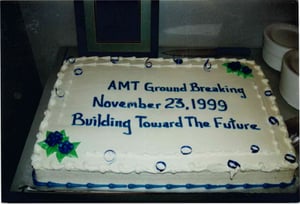
“Our 90 employees moved into the building in September 2000, and we held a formal dedication. Rick Wagner, CEO of General Motors at the time, spoke at the ceremony.”
The First Systems Job
After moving into the new facility, it was only a few months until AMT secured the first systems build, as Mike had envisioned. “That first system was for Guardian Glass. It was a robotic assembly system that used multiple vision systems for robot guidance and inspection to do urethane dispense and glass encapsulation; quite a sophisticated system for your first one. But we were always confident and bold. It was quite successful; we got a repeat order!”
The Guardian Glass project grew out of AMT’s excellence in the engineering services arena. “Over the years, our customers would say to us, ‘you guys should build systems rather than just working for system integrators.’ “
Mike Takes the Reins
In November of 2003, Don left the company to pursue other opportunities. Mike had aggressive growth plans for AMT. The two came to an arrangement and ended their business partnership. “It was important to me that we part amicably as business partners, and we did. We are still friends to this day.”
To pursue AMT’s growth, Mike began an acquisition strategy. AMT first acquired Turtech, a company that designed tooling for automotive body shops, and had a strong mechanical design group. Adding Turtech’s mechanical tooling capabilities to AMT’s controls automation expertise meant being able to do large, turnkey projects for automotive body shops.
In 2008, AMT made its largest acquisition, that of KR Automation, adding KR’s 130 employees to AMT’s 120. KR Automation specialized in controls engineering and panel build, and had very similar and complementary engineering services to AMT, allowing the company to be able to take on larger projects.
“Our timing was terrible because of the 2008-2009 recession. Timing was terrible but the company and the people were great. With a combined 250 employees and two facilities, we were able to bid on and received systems design work for General Motors Detroit-Hamtramck Assembly Shop.”
Dire Straits Force a Tough Decision as the Economy Hits the Skids
“Having the Detroit-Hamtramck project, we were working closely with General Motors. We had their engineers work alongside our engineers, actually coming into our office.” As the economy hit the skids with the recession, General Motors filed for bankruptcy, and AMT’s entire business was at risk. With over 40% of the company’s revenue coming from General Motors, and 20% from this project alone, Mike had to decide whether or not to take a protective stance. He could slow work and furlough employees and try to ride out the recession and GM’s bankruptcy, or he could take a risk and trust the GM executives who were urging him to stick by them and keep the schedule, hoping eventually to be paid.
had their engineers work alongside our engineers, actually coming into our office.” As the economy hit the skids with the recession, General Motors filed for bankruptcy, and AMT’s entire business was at risk. With over 40% of the company’s revenue coming from General Motors, and 20% from this project alone, Mike had to decide whether or not to take a protective stance. He could slow work and furlough employees and try to ride out the recession and GM’s bankruptcy, or he could take a risk and trust the GM executives who were urging him to stick by them and keep the schedule, hoping eventually to be paid.
Mike chose the latter, “We did not stop the work, and we really had the entire company at risk with this decision. When we got to the other side of bankruptcy, we actually got paid in full by General Motors. After going through this with them, our relationships strengthened, so it did work out.”
“The recession and GM’s bankruptcy was a stressful time. We lost about 60% of our business and 40% of our employees. The company got leaner, and we survived, learned a lot, and grew again.”
Turning the Corner, the Company Becomes More Diversified
In 2005, AMT’s business was about 95% in the automotive industry. “We started to consciously diversify the business from automotive, and when the recession hit in 2008, we were less vulnerable than we otherwise would have been.”
AMT continued to follow a strategy of growth. In 2016, we added four employees with the acquisition of Genessee Controls.
Thankful to our Employees, Customers and Partners
“We have had many key customers over the years. Certainly, our relationship with General Motors has been important in our growth over the years. ACME Manufacturing was an early, key customer of AMT. FANUC has been not only a key customer, but a key partner throughout our history.”
Mike especially appreciates AMT’s hardworking and dedicated employees. “As we turn 30, I believe we have the best leadership and the best staff we have ever had at this company. I’m grateful to every employee that has helped make AMT what it is today.”
Today at AMT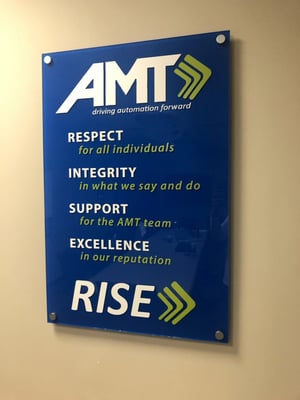
Taking AMT into the company’s fourth decade, Mike describes how continuing education is important for every employee. “We have a culture of learning and continuous improvement, continuous education. I personally still go annually for a week of business school at Harvard to keep pace with the best practices. As we go forward, our industry will change, and the technology will change. Keeping our engineers on the forefront of technology is important to us, and we invest in that.”
This learning culture extends even down to the design of the building. “We have a lab that’s for our employees’ education, it’s not for building systems. It’s for our own learning, and occasionally for development projects with our customers.”
Mike describes the company culture as still having an entrepreneurial flair, and still willing to take risks. “We have our core values and they are important. We are a high-integrity group: we do what we say and we say what we do. We work as a team and we respect people. We do think AMT is a special place.”
An Eye on the Future
Looking forward, Mike believes that manufacturing automation will remain an important part of the economy. “One of the great things about our industry is there will always be a need for good engineers and people to work in this industry. I don’t fear that we are automating ourselves out of work; good people are always needed. I see the need for what AMT does, it will change and it will evolve, but it will continue. I don’t see an end to it.”
With a word of advice, Mike reminisces on AMT’s 30-year journey. “I knew it was going to be a lot of work, but it’s also very fun and rewarding. Along the way I discovered my personal life vision. I believe I’m here to help facilitate people to live and enjoy a fulfilled life. An essential part of that fulfilled life is having productive work that applies your talents.”
This sentiment is reflected in the company’s motto: We exist to build and expand careers. Mike adds, “Because that’s an essential part of a productive and happy life for people.”

